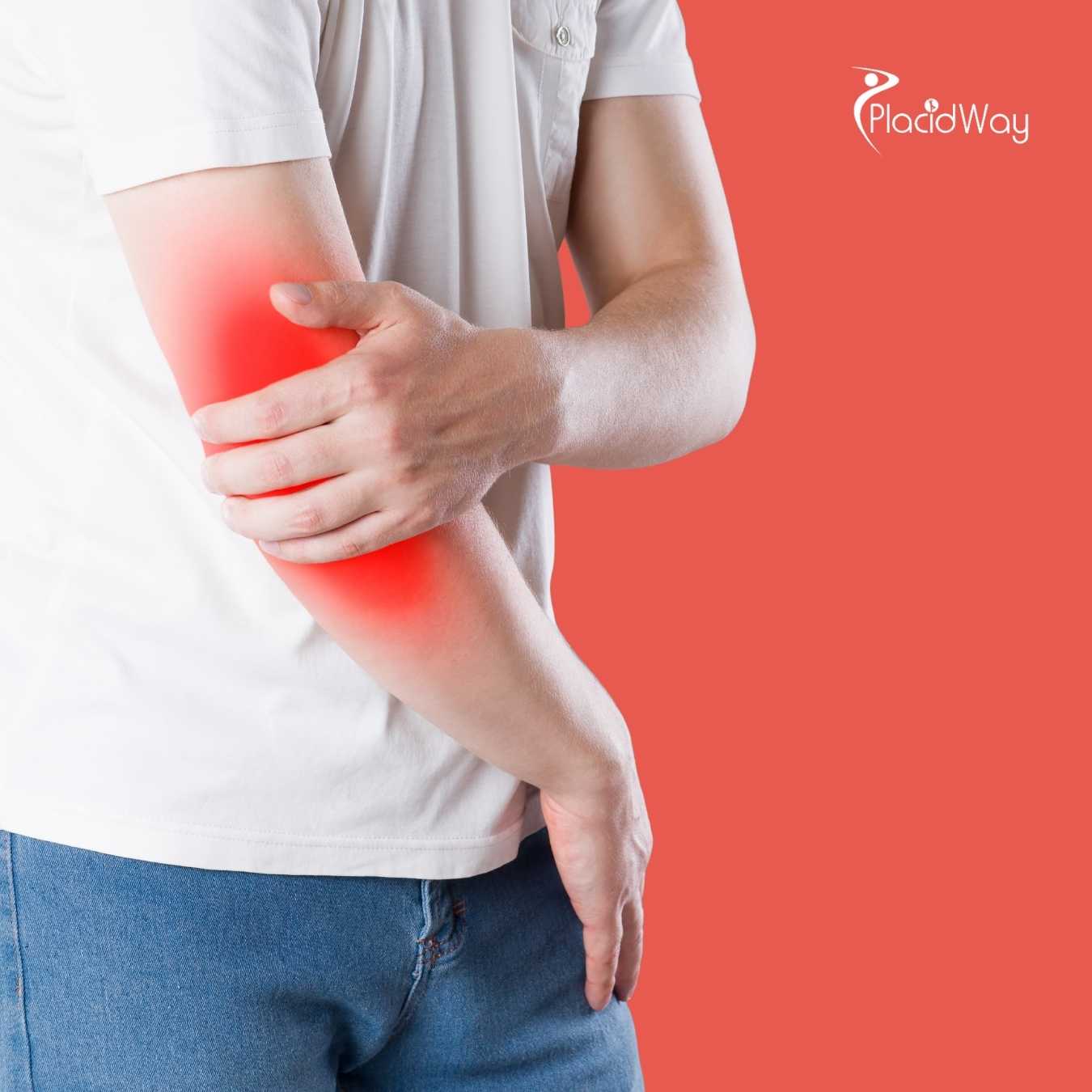.png)
Living with chronic joint pain can feel like a daily battle. Whether it's a stiff, aching knee that protests every stair, a painful hip that limits your mobility, or a shoulder that's lost its range of motion, joint problems can sideline you from the life you want to live. For decades, the path for joint pain was predictable: start with pain pills, move on to cortisone shots, and eventually, face the prospect of a major joint replacement surgery. But what if you could repair the damage instead of just masking the pain or replacing the part?
This is the central idea behind stem cell therapy for joints. This advanced area of regenerative medicine is shifting the entire focus of orthopedic care. Instead of accepting joint degeneration as inevitable, it aims to use your body's own powerful healing mechanisms to rebuild and restore damaged tissue. You've likely heard about athletes using it to get back in the game, but this treatment is now a realistic option for anyone seeking lasting relief from osteoarthritis or chronic joint injuries. This guide will answer all your most pressing questions about how stem cell therapy works, which joints it can treat, what the procedure is really like, and what it costs.
What is stem cell therapy for joints?
Stem cells are unique, "undifferentiated" cells. This means they haven't yet decided what to become. They have two primary jobs: they can create copies of themselves (self-renew) and they can change into specialized cells (differentiate), such as cartilage cells (chondrocytes) or bone cells (osteoblasts).
When injected into an arthritic or injured joint, they release a powerful cocktail of growth factors and anti-inflammatory signals. This process, known as the "paracrine effect," is the treatment's main mechanism. They essentially "coach" the joint's environment, calming down the painful inflammation and signaling your local cells to begin the repair process.
How does stem cell therapy work for joint pain?
In a condition like osteoarthritis, the joint is in a constant state of chronic, low-grade inflammation that breaks down cartilage faster than it can be repaired. Stem cells break this cycle.
- Reduces Inflammation: Mesenchymal Stem Cells (MSCs) are strongly anti-inflammatory. They calm the "fire" in the joint, which provides significant pain relief.
- Stimulates Repair: The cells release growth factors that act like a blueprint for repair, encouraging damaged cartilage and tendons to start rebuilding.
- Protects Cartilage: They can prevent existing, healthy cartilage cells from dying off (a process called apoptosis), effectively slowing down the arthritic process.
- Potential Regeneration: In the right environment, these stem cells may also directly transform into new cartilage cells, helping to patch the damaged areas.
Which joints can be treated with stem cell therapy?
The effectiveness is high across these areas because the underlying problem is often the same: osteoarthritis or chronic tendon/ligament damage.
- Stem Cell Therapy for Knees: This is the most common application, used to treat osteoarthritis, meniscus tears, and ligament injuries (like partial ACL or MCL tears).
- Stem Cell Therapy for Hips: A powerful option for treating hip osteoarthritis and labral tears, often helping patients delay or avoid total hip replacement.
- Stem Cell Therapy for Shoulders: Highly effective for rotator cuff tears (partial), tendinopathy, and shoulder arthritis.
- Other Joints: It is also successfully used for ankle arthritis, Achilles tendinopathy, "tennis elbow," and arthritis at the base of the thumb.
Is stem cell therapy effective for knee osteoarthritis?
For patients with mild-to-moderate knee arthritis, it can be a game-changer. It directly addresses the inflamed joint environment and damaged cartilage, offering benefits that go far beyond a temporary cortisone shot.
It's also a valuable tool for specific knee injuries. For example, it can be used to treat meniscus tears. Instead of surgery to remove the torn piece (a meniscectomy, which can accelerate arthritis), stem cell therapy aims to heal the tear, preserving the vital shock-absorbing cushion of the knee.
Can stem cell therapy help hip joint pain?
Because the hip is a deep, load-bearing joint, injecting it requires high precision, which is why the procedure is always done using live X-ray (fluoroscopy) or ultrasound guidance.
It's also used to treat other hip conditions, such as avascular necrosis (AVN) in its early stages, where bone tissue is dying due to a lack of blood supply. The stem cells can help improve blood flow and stimulate new bone growth.
What about stem cell therapy for shoulder pain?
Surgery for a rotator cuff tear typically involves stitching the torn tendon back to the bone, which requires a very long and painful recovery in a sling. Stem cell therapy offers a non-surgical option.
By injecting the stem cells directly into the partial tear under ultrasound guidance, the goal is to stimulate the tendon to repair itself without an incision. This results in a much faster recovery and avoids the risks associated with surgery.
Am I a good candidate for stem cell joint therapy?
Your doctor will use your medical history, a physical exam, and imaging (X-rays and/or MRI) to determine if you're a good fit. You are likely a good candidate if:
- You have been diagnosed with osteoarthritis but are not yet "bone-on-bone."
- You have a partial tendon or ligament tear (e.g., rotator cuff, meniscus).
- You are in good general health.
- You wish to use your body's own healing ability and avoid a large operation.
It is generally not recommended for severe "bone-on-bone" arthritis, as there is no cartilage left to save. In those cases, joint replacement is often the only effective option.
What is the procedure for a stem cell joint injection?
The entire process takes 1-2 hours, and you go home the same day. Here are the steps:
- Harvest: After numbing the area (usually the back of your hip), the doctor uses a special needle to draw out a small amount of bone marrow aspirate. This is the most common source for orthopedic procedures. Some doctors may use a mini-liposuction to get stem cells from adipose (fat) tissue.
- Concentration: The harvested sample is processed in a centrifuge, which spins it at high speed to separate and concentrate the stem cells, platelets, and growth factors into a small, powerful injectate.
- Injection: The doctor numbs the target joint (e.g., your knee or shoulder). Then, while watching a live ultrasound or X-ray screen, they guide the needle to the exact point of injury and inject the stem cell concentrate.
Where do the stem cells come from?
Using your own cells (autologous) is the key. It means there is zero risk of rejection, allergic reaction, or disease transmission.
- Bone Marrow Aspirate Concentrate (BMAC): Harvested from the iliac crest (hip bone). This is rich in Mesenchymal Stem Cells (MSCs) and hematopoietic stem cells, which are excellent for orthopedic repair.
- Adipose-Derived Stem Cells: Collected via mini-liposuction. Fat is a very dense source of MSCs, and the procedure is often very easy to tolerate.
The choice often depends on the doctor's training and the specific joint being treated.
Is the stem cell procedure for joints painful?
The bone marrow aspiration is often the part patients are most worried about. With proper numbing, it's typically described as a brief, strange feeling of deep pressure. The joint injection itself is very similar to a standard cortisone shot.
After the numbing wears off, you can expect post-procedure soreness for 2-5 days. This is a good sign; it's the normal inflammatory response that kicks off the healing. This is managed with ice and Tylenol (acetaminophen), not anti-inflammatories like Ibuprofen.
What is the recovery time for stem cell joint therapy?
It's vital to remember that this is a biological repair, not a quick fix. The cells need time to work.
- First 1-2 Weeks: You'll be asked to take it easy and avoid stressing the joint, sometimes using crutches for a knee or hip, or a sling for a shoulder.
- Weeks 2-8: You'll start a specific physical therapy program to restore motion and gradually build strength. This is critical to guide the new tissue as it forms.
- Months 3-6+: This is when most patients feel the "wow" effect. The pain is significantly down, and they can return to more advanced activities. The tissue will continue to remodel and strengthen for up to a full year.
How much does stem cell therapy for joints cost?
This cost is generally not covered by insurance, as it's still considered "investigational." The price reflects the entire process: the doctor's specialized time for the harvest, the sterile processing by a lab technician, the expensive disposable equipment, and the high-level expertise needed for the image-guided injection.
When considering the cost, it's important to weigh it against the alternatives, such as surgical deductibles and lost time from work.
Cost Comparison for Common Joint Treatments (USA)
| Treatment | Average Cost (Out-of-Pocket) | Procedure Type | Recovery Time |
|---|---|---|---|
| Stem Cell Therapy (Knee) | $4,000 - $8,000 | Minimally invasive | 3-6 months (for full effect) |
| Stem Cell Therapy (Hip) | $5,000 - $10,000 | Minimally invasive | 3-6 months (for full effect) |
| Stem Cell Therapy (Shoulder) | $4,000 - $9,000 | Minimally invasive | 3-6 months (for full effect) |
| PRP Injection (Any Joint) | $500 - $1,500 | Minimally invasive | 4-6 weeks |
| Total Knee Replacement | $3,000 - $10,000+ (Deductible/Co-pay) | Invasive Surgery | 6-12 months |
Are there any risks or side effects of stem cell joint injections?
The most common side effect is a temporary "flare-up" of pain and soreness in the joint for a few days after the injection. This is a normal and expected part of the healing response.
To ensure safety, it is critical to choose a highly-qualified doctor who performs the procedure under sterile conditions and uses image guidance (ultrasound or X-ray) for precise placement.
How long do the effects of stem cell therapy last?
The goal is a structural repair, not a temporary fix. However, the longevity depends on the severity of your arthritis at the time of treatment, your overall health, and your activity level. The treatment doesn't stop you from aging, but it can significantly "turn back the clock" on joint degeneration.
Stem cell therapy vs. PRP for joints: What's the difference?
Think of PRP as a cup of strong coffee that gives your local repair cells a jolt of energy. Think of stem cells as a full construction crew arriving with new materials (the cells) and the blueprints (the growth factors) to rebuild the site.
PRP is excellent for mild conditions and tendinitis. Stem cell therapy is more powerful and is typically reserved for more significant conditions, like moderate osteoarthritis and partial tendon tears.
Stem cell therapy vs. cortisone shots for joint pain?
Cortisone is a quick fix. The pain almost always comes back, and studies show that repeated cortisone injections can actually damage cartilage and weaken tendons, making the problem worse over time.
Stem cell therapy takes longer to work (weeks to months), but the goal is a lasting solution by healing the underlying injury. Most regenerative medicine doctors will ask you to avoid cortisone shots for at least 3 months before a stem cell procedure, as the steroid can be toxic to stem cells.
Stem cell therapy vs. joint replacement surgery?
Stem cell therapy is an option for mild-to-moderate arthritis, aiming to prevent the need for surgery. It has a low-risk profile and a quick recovery.
Joint replacement is a last resort for severe, "bone-on-bone" arthritis. It is highly effective for relieving pain but comes with significant surgical risks (infection, blood clots) and a long, painful rehabilitation period of 6-12 months. Stem cell therapy is an attempt to heal the joint so you never have to face that.
What should I do to prepare for my joint procedure?
Your clinic will give you a full list of instructions, which usually includes:
- Avoiding blood-thinning supplements like fish oil and Vitamin E.
- Staying well-hydrated in the days leading up to the procedure.
- Arranging for a driver to take you home.
- Planning to rest and "baby" the joint for the first few days.
What is the success rate of stem cell therapy for joints?
Success is highly dependent on proper patient selection. A 45-year-old with a partial meniscus tear and mild arthritis will likely have a better outcome than a 70-year-old with advanced, bone-on-bone arthritis.
A successful outcome is typically defined as more than 50% reduction in pain and the ability to return to activities you were previously unable to do, all while avoiding a major surgery.
How many stem cell treatments will I need?
In some very severe or complex cases, a doctor might recommend a follow-up injection of PRP (Platelet-Rich Plasma) 3-6 months later to act as a "booster" to the stem cells, but this is not always necessary. The vast majority of reputable clinics focus on a single, comprehensive stem cell treatment (from bone marrow or fat) as the primary intervention.
Ready to Find a Solution for Your Joint Pain?
Chronic joint pain doesn't have to be your future. PlacidWay is your trusted partner in navigating global healthcare options. We connect you with pre-screened, world-class clinics and leading experts in regenerative medicine and stem cell therapy for joints.
Discover if this life-changing treatment is right for you. Contact PlacidWay today for a personalized, free quote and explore your path to recovery!
Stem Cell Therapy Abroad










Share this listing